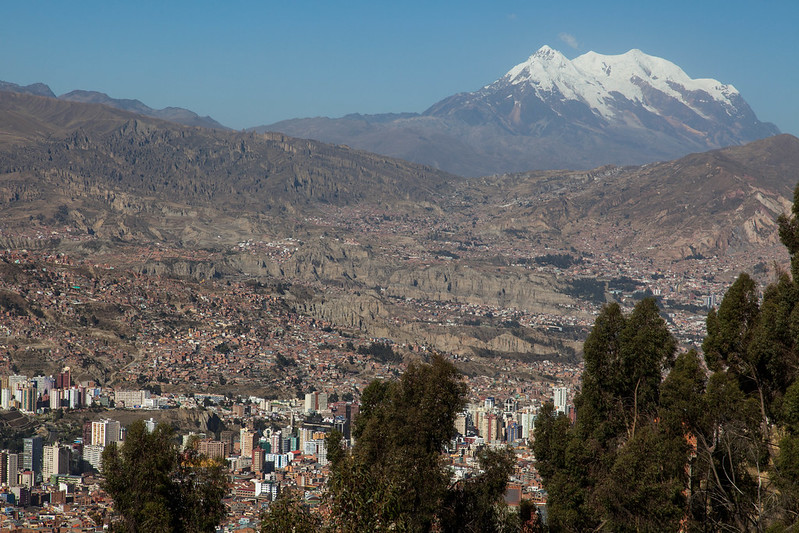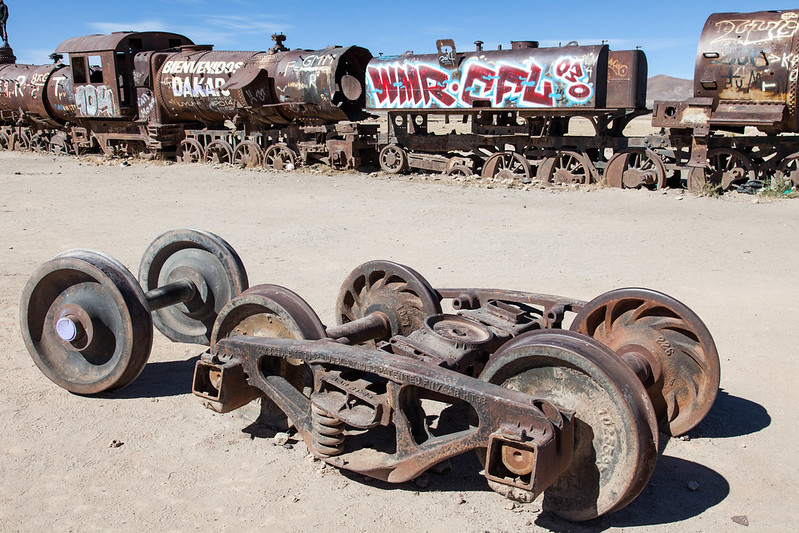 |
Do my feet look big in these?
Dinosaur footprints near Marawa. |
Time to leave the cold world of Uyuni and go somewhere warmer - in other words, somewhere lower. We took the bus to Potosi: both a major mining centre in Bolivia and a beautiful town of yellow buildings and picturesque balconies. From there, our destination of Sucre was only a few hours away. The road took us down, down, down to a world where vegetation isn't confined to dry, golden grasses and birds other than flamingos feed.
The centre of Sucre is beautiful: every building is white with a wooden balcony and tiled roof. Ribbons of them snake up the many hillsides on which the town is built, with cobbled streets woven into the pattern. And when I say white houses, I mean WHITE; not the greying facades of an ageing European city. Alas, there is a terrible reason for this. Bolivian towns are razed to the ground by earthquakes so regularly that white buildings lack the time to fade. Many of Sucre's colonial buildings were last destroyed in the 1940s.
 |
| Typical Sucran street view |
Despite the stunning surroundings, we felt trepidatious. We were arriving in a Bolivian city without a tour guide for the first time and we had been warned about the number of kidnappings. At the bus station, notices warned us only to take taxis from the official taxi rank, not the street. A police officer reinforced the message and found us a cab to take us into the centre - a distance of only a couple of kilometres. It took ages. This couldn't be only a couple of kilometres. As the journey dragged on, we glanced at each other. Perhaps the police officer was a fake; we'd read about those. Perhaps the uniform was all part of the hoax. Perhaps we were experiencing our first Bolivian kidnapping? Then the taxi driver pulled up outside our hostel, accepted his fare and went on his way. Panic over. We wandered into the centre of Sucre, which was decidedly well-to-do; we had better stow away our fears until we reached La Paz.
In the meantime, Sucre had plenty to offer. After a day around the town, we arranged a two-day trekking trip and set out with our friendly guide, David. The first couple of hours of walking took us down an Inca trail (I wonder how many of them there are in Bolivia? And what is the dollar value of being able to add the word 'Inca' in front of the word 'trail'? Substantial, surely?). The trail led down a steep hillside into the valley, where we spent a couple of hours following the river to a church. "The priest only comes here for one month a year," David told us, "so everyone has to get married or christened then." In the meantime, the eucalyptus trees preside over the site, dropping their leaves so the crops cannot grow. "It's like a plague," David told us.
 |
| Aerial view of the Marawa crater (courtesy of Google Maps) |
Later in the afternoon we headed up a steep path towards Marawa crater (which, for the record, is not a crater, although a more appropriate definition remains elusive). The crumbling path, with a sheer drop to one side, looked improbable in places; thank goodness for the guide who came back and held climber-Susan's hand over the scary bits to save her from spending the afternoon gibbering over them. Meanwhile a tiny old lady from the village below, wearing top-brand trekking gear (a cloth skirt and brightly-coloured shawl - come on North Face, get with it), skipped past us with ease and sprinted on towards the top of the path leaving us trailing in her wake.
 |
| Approaching the rim of the "crater" (probably actually an syncline) |
 |
| Little old lady crossing the bridge kitted in technical Bolivian mountaineering gear. |
Eventually we reached the Quechua-speaking village of Marawa - a place of many colours and few teeth. As well as the customary scattering of biscuit wrappers outside the village (nemesis of said teeth?), it is home to a large school serving the surrounding villages, a small shop (with beer in stock), and surrounding hillsides that look like a sequence of giant conch shells ranged around the rim of the crater. We spent a pleasant evening there.
Next morning, as we climbed out of the village, we passed a number of children dashing down the hillsides to the school. David told us that the children pretend to be frightened of tourists because their parents tell them that, if they aren't good, a foreigner will take them away in a backpack. On hearing this, Guy pretended to lunge for a couple of kids and was greeted by shrieks of laughter. In addition to their Spanish lessons at school, they are learning a little business early. Almost every child had fistful of woven bracelets and fossils to try to sell to us. But we felt the weight of our backpacks and decided against adding any rocks to them.
 |
| Leaving the Marawa crater |
 |
| Bullocks to the trail |
For the next couple of hours, Guy was entranced by the geology of the area. If Marawa crater isn't a crater, what is it? How was it formed? He turned over various theories in his mind and tried them out on David and I. They included words like sink-lines and concoidal fractures. David and I perfected the art of nodding and smiling. Professor Guy may have to fail us both in our geology lessons.
In late morning, we reached a slab of rock tilted to about thirty degrees. A clear line of footprints from a large theropod dinosaur ran across one edge; a sauropod dinosaur had taken a slightly different route up the centre; some smaller theropods had scuttled around at random. The theropod prints were pristine and a group of French tourists posed as dinosaurs with their faces scrunched up, their hands extended as claws, and their feet in the prints. Guy was disgusted; these fossils may not be pristine for very much longer if many such groups come this way. Fortunately a group of Palaeontologists have spent a year studying the traces and taking casts so the record won't be lost.
From the dinosaur rock we headed down into the valley towards our vegetarian packed lunch (chicken - what else would you feed a vegetarian?). Power lines climbed the hillsides to the villages we passed on the way and I asked if they were new. "Yes," David told us, "they were installed a few months ago. There is a Presidential election this autumn." The electric lighting in Marawa was part of the same programme and equally new. So was the President trying to woo voters in the villagers? David thought so. "Yet the villagers don't have to pay any taxes," he added. We scented a slight note of being hard-done-by in the voice of this urban tax-payer.
One more question; what about health care in the villages? "A wheelbarrow is the best ambulance," David told us, "donkeys are too slow, so you need a wheelbarrow to get to the nearest town." Of course, of course. A wheelbarrow!
 |
| Red soil at the end of the trek |
After two days of trekking amidst sunshine, intriguing rock formations and cretaceous remains, we drove back to Sucre. I could have used a hand to hold on the return journey as our van drove much closer to a precipice than my feet had taken me the previous day. But that's the norm here so I'd better get used to it. At least there was a hearty dinner in a Dutch cafe to fortify us back in Sucre. Why Dutch? No idea.
 |
| Climbing one of the new routes |
We had one more day left in Sucre so Guy went rock climbing on a nearby crag with a couple of well-reputed climbers from the area. The low points were wading a sewage outlet to get to the crag and listening to the frustration of the climbing guides that the local tourist outfits won't give
them any support to set new routes in the area - only to offer half-day beginners' climbing experiences to backpackers. The high points: the second ascent of a new route on excellent rock and the ability still to on-sight F6b (albeit on a top-rope!).
Susan, meanwhile, visited the 'Casa de la Constitucion' and other museums. Sucre is constitutionally the capital of Bolivia as everyone who has visited the town will know. ('Sucre, capital of Bolivia' screams from many buildings.) "It's still the capital," we were told, "even though the government sits in La Paz". I wonder how they feel about that in La Paz? Well, time to find out. We donned our down jackets and boarded the night bus, ready for a chilly ride to the city that, if the Sucrites are to be believed, isn't the capital after all. A few days previously this wouldn't have been possible as industrial action had locked the roads into La Paz but, with the strike over, we were free to continue on our way.























































